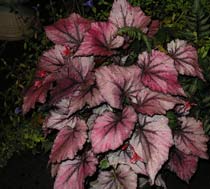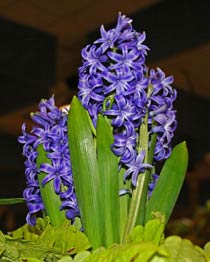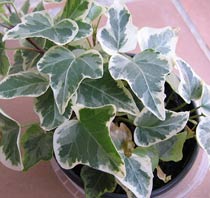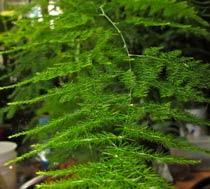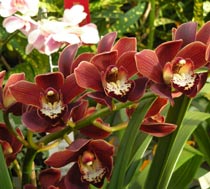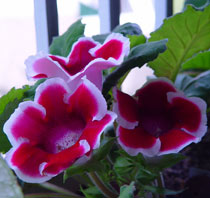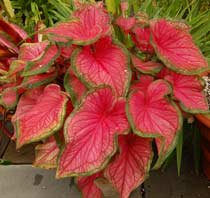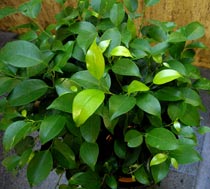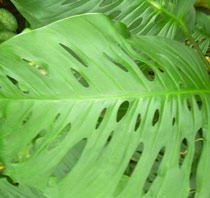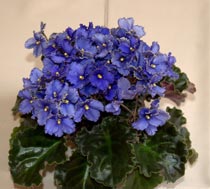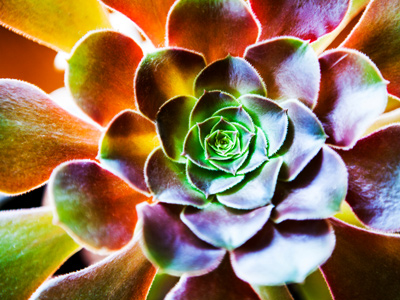
Houseplants come in a wide variety.
Houseplants - Houseplants 2
It is an unfortunate fact of houseplant growing that the more ordinary a plant looks, the longer it will last in the home.
A gloxinia will look spectacular for a short while but a swiss cheese plant will be only a baby when the gloxinia dies. A caladium will keel over and die if you look at it the wrong way but an ivy will still be happily waiting for you if you leave it in a freezing house while you go on holiday for a fortnight. You pays your money....
1.
To grow well, begonia rex requires which of the following?
Constantly wet compost
High humidity
High level of nutrients
High temperature
- There are numerous varieties with fascinating combinations of coloured leaves.
- The rule of thumb is that the lower the temperature the more light the plant requires.
- In the depths of winter it is best to keep in the sunniest position in the home.
- Take care not to over-water because waterlogged compost results in the plant rotting.
Begonia rex can withstand fairly low temperatures provided the compost is not too wet
2.
To get hyacinths flowering inside for Christmas you will need to give them a cold treatment lasting how long?
2 weeks
5 weeks
8 weeks
11 weeks
- Hyacinths naturally flower in the spring but specially treated bulbs can be bought that can be persuaded to come into flower early.
- Making bulbs flower early is known as 'forcing'.
- Bulbs should be planted in containers before the cold treatment begins.
- The ideal temperature for the cold treatment is 2 - 8 degrees C. This can be achieved by wrapping the containers in a polythene bag and keeping them in a refrigerator. If this is not possible then a cold shed will suffice or failing that keep them outside. Take great care not to get the containers frosted because this will damage or kill the bulbs.
3.
Which type of ivy is this?
Canariensis
Colchica
Helix
Hibernica
- The non-variegated form is unexciting and seldom grown but the variegated forms (such as the one shown) can make excellent houseplants.
- In deep shade it will lose the colouring of the leaves and revert back to plain old green!
- It will tolerate a wide range of temperatures and even light frosts do not harm it.
- When growing strongly it requires a weekly dose of fertilizer and it will also need some form of support.
4.
The edible asparagus is asparagus officinalis. The closely related plant that is grown as a houseplant is called what?
Asparagus deliciosus
Asparagus decorosus
Asparagus fernosus
Asparagus plumosus
- Sometimes referred to as the lace fern although it is not a fern at all.
- A native of South Africa.
- Foliage is sometimes used in floral decorations but it is best not to denude your prize houseplant for this purpose!
- Considering its very delicate appearance it is surprisingly drought-resistant.
- Compost should be allowed to become quite dry before watering.
5.
What type of orchid is this?
Cymbidium
Cymberbidum
Cymberitum
Cymsersitum
- This is the type of orchid that is most widely used as a houseplant.
- Flowers come in virtually every conceivable colour combination.
- Not as difficult to grow as the delicate flowers would suggest but you require a greenhouse or conservatory to persuade it to flower a second time.
- In cool conditions an individual flower will remain in pristine condition for several weeks.
6.
When growing a gloxinia from a tuber how deep should the tuber be planted?
Sitting on the surface
Lightly covered
An inch below the surface
Two inches below the surface
- Extremely showy plants that can either be purchased in bloom or (if you are more adventurous) grown from tubers.
- Like its close relative the saintpaulia it does not like water on its foliage.
- Gloxinia connoisseurs usually insist that the plant is stood in tepid water for up to an hour so that the compost sucks it up from the bottom.
- Strong sunlight will scorch the developing leaves whilst too little light will make them stretch and go leggy.
7.
This plant is variously known as heart of Jesus, angel wings and elephant ears but what is its scientific name?
Caladium
Chamaeodora
Chlorophytum
Crassula
- There are over 1,000 named varieties with wonderful leaf patterns of pink, red and white.
- Most varieties can grow to about 60 cms square under ideal conditions.
- Plants are grown from corms which go dormant during the winter and then grow quickly from spring onwards.
- Keep the growing plant moist at all times.
- They are not easy to grow in the house but they make admirable conservatory plants that can occassionally be moved around to other rooms.
8.
This is a Ficus benjamina. To which group of plants do Ficus belong?
Eucalyptus
Figs
Palms
Spruce
- Native to Asia and Australia.
- Easy to grow in homes and offices.
- There are a number of variegated forms but these are more difficult to look after than the plain green form.
- It is noted as a plant that adds a degree of elegance and sophistication wherever it is seen.
- Once settled it dislikes being moved and will quickly show its annoyance by dropping several leaves!
9.
This leaf pattern is typical of which houseplant?
Money plant
Rubber plant
Swiss cheese plant
Zebra plant
- Latin Name: Monstera deliciosa.
- In Mexico an infusion is made from the roots which is believed to relieve the symptoms of arthritis!
- It grows quickly when provided with adequate warmth (over 20 degrees C), shade and high humidity - all but the last are easily provided in the home.
- Frequent misting of the plant helps.
- As it grows it will need firm supports - poles wrapped in moss are often used.
10.
What is the name of this plant?
Saintpaulia
Sanseveria
Sinnigia
Spathiphyllum
- The common name for this plant is African violet.
- Originates from Tanzania and Kenya.
- Available in a wide range of colours including blues, purples, reds and whites.
- Recent breeding work has produced double flowers.
- Temperatures should not be allowed to fall below 15 degrees C.
- Cold water is a definite no no! Ensure that all water used has been warmed to room temperature.
**Unlimited Quizzes Await You! 🚀**
Hey there, quiz champ! 🌟 You've already tackled today's free questions.
Ready for more?
Ready for more?
🔓 Unlock UNLIMITED Quizzes and challenge yourself every day. But that's
not all...
not all...
🔥 As a Subscriber you can join our thrilling "Daily Streak" against other
quizzers. Try to win a coveted spot on our Hall of Fame Page.
quizzers. Try to win a coveted spot on our Hall of Fame Page.
Don't miss out! Join us now and keep the fun rolling. 🎉
**Unlimited Quizzes Await You! 🚀**
Hey there, quiz champ! 🌟 You've already tackled today's free questions. Ready for more?
🔓 Unlock UNLIMITED Quizzes and challenge yourself every day. But that's not all...
🔥 As a Subscriber you can join our thrilling "Daily Streak" against other quizzers. Try to win a coveted spot on our Hall of Fame Page.
Don't miss out! Join us now and keep the fun rolling. 🎉





